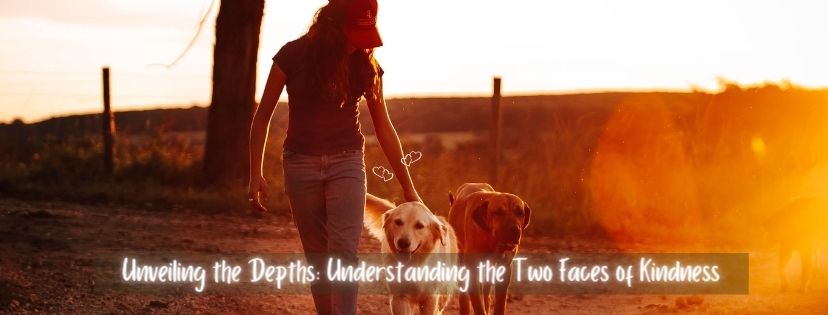Kindness is a multifaceted concept that goes beyond simple acts of niceness. It encompasses a deeper understanding of human interactions and the impact they have on others. In this article, we will delve into the intricacies of kindness and explore its two distinct faces. Join us on this journey as we uncover the true essence of kindness and how it can shape our relationships and personal growth.
The Importance of Kindness: A Closer Look
The Difference between Being Nice and Being Kind
Kindness and niceness are often used interchangeably, but they hold different meanings. Being nice typically refers to surface-level politeness, while kindness delves deeper into empathy, compassion, and genuine care for others. Understanding this distinction is crucial as it forms the foundation for comprehending the two faces of kindness.
The First Face of Kindness: Mercy and Relief
The first face of kindness revolves around mercy and relief. It entails refraining from adding insult to injury and offering support to those experiencing difficulties. Whether it’s extending a helping hand, providing solace, or simply being there to listen, this face of kindness aims to alleviate suffering and foster understanding.
The Second Face of Kindness: Loving Honesty and Intervention
The second face of kindness is less commonly acknowledged but equally important. It involves loving honesty and intervention when necessary. True kindness does not allow others to continue harming themselves unnecessarily. It requires recognizing patterns of self-destruction and approaching individuals with care and concern, even if it means addressing uncomfortable truths.
Navigating the Two Faces of Kindness: A Step-by-Step Approach

Understanding the two faces of kindness is one thing, but putting them into practice is another. Here’s a step-by-step process to help you navigate these different aspects of kindness:
Step 1: Differentiate between Being Nice and Being Kind
Start by understanding the difference between niceness and kindness. Recognize that kindness requires a deeper level of empathy, whereas niceness may be more superficial.
Step 2: Refrain from Causing Harm
In your interactions with others, consciously avoid adding insult to injury. Be mindful of your words and actions, ensuring that you do not worsen someone’s problems through judgment or punishment.
Step 3: Offer Relief and Support
Extend kindness by offering appropriate relief and support to those who are struggling. Whether it’s lending a listening ear, providing a helping hand, or simply showing empathy, small acts of kindness can make a significant difference.
Step 4: Embrace Loving Honesty
Recognize when someone’s behavior is self-destructive and approach them with loving honesty. Express your concerns genuinely and without judgment, emphasizing the potential negative impact on their well-being and relationships.
Step 5: Respect Autonomy and Accept Responses
Understand that individuals have their own autonomy and choices. Respect their decisions and responses, even if they may not align with your intentions. Kindness lies in the act of extending help, regardless of the outcome.
Frequently Asked Questions about the Two Faces of Kindness
Here are some common questions that arise when exploring the concept of the two faces of kindness:
1. Does kindness require accountability?
Yes, kindness inherently involves accountability. Being truly kind means recognizing when someone’s behavior is self-destructive and intervening from a place of love and truth.
2. How can I differentiate between being nice and being kind?
Being nice often focuses on surface-level politeness, while kindness encompasses deeper empathy and compassion for others.
3. What if my efforts to help someone are rejected?
Respect the autonomy of others and understand that their response is ultimately their choice. Even if your help is not immediately accepted, the act of extending a helping hand is a testament to your kindness.
4. Is it important to be kind to ourselves?
Absolutely! Being kind to ourselves is crucial for personal growth and resilience. Treat yourself with the same compassion you would extend to others and avoid excessive self-criticism.
5. How can I express concern for someone without being judgmental?
When expressing concern, focus on observations and how their behavior impacts their well-being and relationships. Emphasize your care and desire to maintain a healthy connection without moralizing or complaining.
Conclusion
Understanding the two faces of kindness allows us to cultivate deeper empathy, compassion, and meaningful connections with others. It goes beyond surface-level niceness and requires us to embrace both mercy and loving honesty. By navigating the complexities of kindness, we can positively impact the lives of those around us and foster personal growth. So, let us strive to be kind, not just nice, and make a difference in the world through our actions and interactions.
Remember, kindness has two faces, and by embracing both, we can truly transform lives and create a more compassionate society.
Dr. Orion Taraban is a renowned psychologist and the host of “Cycax Better Living Through Psychology” on YouTube. With a wealth of knowledge and expertise in the field of psychology, Dr. Taraban offers engaging and enlightening content that helps individuals navigate various aspects of life. Visit Dr. Taraban’s YouTube channel to explore more captivating videos on psychology and personal growth.

